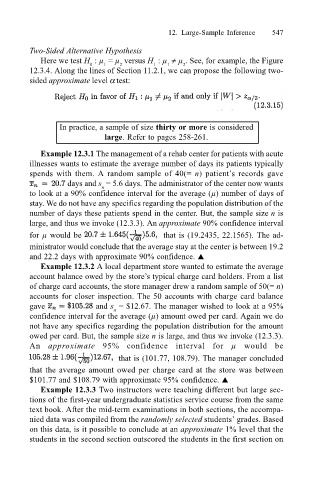Page 570 - Probability and Statistical Inference
P. 570
12. Large-Sample Inference 547
Two-Sided Alternative Hypothesis
Here we test H : µ = µ versus H : µ ≠ µ . See, for example, the Figure
2
1
0
1
2
1
12.3.4. Along the lines of Section 11.2.1, we can propose the following two-
sided approximate level α test:
In practice, a sample of size thirty or more is considered
large. Refer to pages 258-261.
Example 12.3.1 The management of a rehab center for patients with acute
illnesses wants to estimate the average number of days its patients typically
spends with them. A random sample of 40(= n) patients records gave
days and s = 5.6 days. The administrator of the center now wants
n
to look at a 90% confidence interval for the average (µ) number of days of
stay. We do not have any specifics regarding the population distribution of the
number of days these patients spend in the center. But, the sample size n is
large, and thus we invoke (12.3.3). An approximate 90% confidence interval
for µ would be that is (19.2435, 22.1565). The ad-
ministrator would conclude that the average stay at the center is between 19.2
and 22.2 days with approximate 90% confidence. !
Example 12.3.2 A local department store wanted to estimate the average
account balance owed by the stores typical charge card holders. From a list
of charge card accounts, the store manager drew a random sample of 50(= n)
accounts for closer inspection. The 50 accounts with charge card balance
gave and s = $12.67. The manager wished to look at a 95%
n
confidence interval for the average (µ) amount owed per card. Again we do
not have any specifics regarding the population distribution for the amount
owed per card. But, the sample size n is large, and thus we invoke (12.3.3).
An approximate 95% confidence interval for µ would be
that is (101.77, 108.79). The manager concluded
that the average amount owed per charge card at the store was between
$101.77 and $108.79 with approximate 95% confidence. !
Example 12.3.3 Two instructors were teaching different but large sec-
tions of the first-year undergraduate statistics service course from the same
text book. After the mid-term examinations in both sections, the accompa-
nied data was compiled from the randomly selected students grades. Based
on this data, is it possible to conclude at an approximate 1% level that the
students in the second section outscored the students in the first section on

